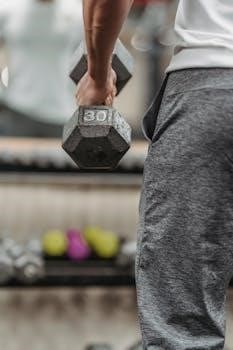meal plan for weight loss and muscle gain male pdf
Embarking on a fitness journey requires a well-structured approach, and a personalized meal plan is paramount for achieving both weight loss and muscle gain. This guide will provide the essential information for men looking to optimize their physique through strategic nutrition, tailored for success in fitness goals.
Calorie Needs for Men⁚ Weight Loss and Muscle Gain
Understanding your individual calorie needs is the foundation of any successful weight loss or muscle gain strategy. For men, these needs are influenced by factors like age, weight, height, activity level, and metabolic rate. To lose weight, you need to consume fewer calories than you burn, creating a calorie deficit.
Conversely, to gain muscle, you need to consume more calories than you burn, providing your body with the energy and resources it needs to build new muscle tissue. A general guideline for weight loss is to reduce your daily calorie intake by 500-750 calories, resulting in a loss of 1-2 pounds per week.
For muscle gain, a surplus of 250-500 calories per day is typically recommended, leading to a gain of 0.5-1 pound per week. It’s crucial to track your progress and adjust your calorie intake accordingly, as individual responses can vary.
Consider consulting with a registered dietitian or nutritionist to determine your specific calorie needs and develop a personalized meal plan that aligns with your goals and preferences. This will ensure a safe, sustainable, and effective approach to achieving your desired results.
Remember that these are just general guidelines, and your individual calorie needs may vary.
Protein Intake⁚ The Cornerstone of Muscle Building
Protein is an essential macronutrient, particularly crucial for men aiming to build muscle. It serves as the building block for muscle tissue, aiding in repair and growth after exercise. Adequate protein intake is vital for maximizing muscle protein synthesis, the process by which your body repairs and builds new muscle fibers.
The recommended daily protein intake for individuals engaged in resistance training is typically between 1.6 to 2.2 grams per kilogram of body weight. This range ensures that your body has sufficient protein to support muscle growth and repair.
For example, a 70kg male should aim for approximately 112 to 154 grams of protein per day. Distribute your protein intake evenly throughout the day, consuming protein at each meal to maintain a steady supply of amino acids to your muscles.
Excellent protein sources include lean meats like chicken, turkey, and fish, as well as eggs, dairy products, legumes, and protein supplements such as whey protein. Incorporating a variety of these sources into your diet will provide a complete range of essential amino acids necessary for optimal muscle development.
Remember that consistency is key, so prioritize protein intake in your daily meal plan to achieve your muscle-building goals effectively.
Sample Meal Plan (2500 Calories)
This sample meal plan provides a framework for a 2500-calorie diet suitable for men aiming to lose weight and gain muscle. Adjust portion sizes based on individual needs and activity levels.
Breakfast (450 Calories)⁚
- Omelet with 3 whole eggs, 4 egg whites, red bell pepper, red onion, and cilantro
- 1 cup oatmeal with cinnamon and sweetener
Mid-Morning Snack (250 Calories)⁚
- 1 scoop whey protein isolate
- 1 medium-sized banana
Lunch (600 Calories)⁚
- 200g chicken breast
- 200g green beans/broccoli
- 1 cup brown rice
Pre-Workout Snack (200 Calories)⁚
- Apple with 1 tablespoon natural peanut butter
Dinner (600 Calories)⁚
- 250g Hake (or other lean fish)
- 200g mixed vegetables
- 1 sweet potato
Pre-Bed Snack (400 Calories)⁚
- 1 cup Greek yogurt
- 1/2 cup berries
- Small handful of almonds
This plan prioritizes high-protein sources to support muscle growth while maintaining a calorie deficit for weight loss. Adjustments can be made to carbohydrate and fat sources based on personal preferences and dietary needs. Remember to stay hydrated throughout the day.
Meal Timing and Frequency
Strategic meal timing and frequency are crucial components of a successful weight loss and muscle gain plan. Distributing your daily calorie and macronutrient intake across multiple meals can optimize muscle protein synthesis and regulate hunger levels.
Aim for 5-6 meals per day, spaced approximately 3-4 hours apart. This approach ensures a consistent supply of amino acids to your muscles, promoting growth and repair. A pre-workout meal, consumed 1-2 hours before training, should include carbohydrates for energy and protein for muscle protection.
The post-workout meal, consumed within 1-2 hours after training, is particularly important for replenishing glycogen stores and initiating muscle recovery. This meal should contain a combination of fast-digesting carbohydrates and protein.
Consider consuming a casein protein source before bed. Casein is a slow-digesting protein that can help prevent muscle breakdown during sleep. Consistency in meal timing is also key. Establishing a regular eating schedule can improve metabolic function and hormone regulation. Experiment with different meal timings to find what works best for your body and lifestyle.
Prioritize protein intake at each meal to maximize muscle protein synthesis. Adjust carbohydrate and fat intake based on your individual needs and activity levels.

Breakfast Ideas for Muscle Gain and Fat Loss
Breakfast is a crucial meal for jumpstarting your metabolism and setting the tone for a day of successful muscle gain and fat loss. A well-balanced breakfast should prioritize protein, complex carbohydrates, and healthy fats to provide sustained energy and support muscle recovery.
One excellent option is an omelet made with 3 whole eggs and 4 egg whites, packed with vegetables like red bell pepper and onion. Pair this with a cup of oatmeal topped with cinnamon and a touch of sweetener for a carbohydrate source.
Another great choice is Greek yogurt with berries and a handful of almonds. The yogurt provides protein, the berries offer antioxidants, and the almonds contribute healthy fats. A protein smoothie is also a quick and convenient option. Blend whey protein isolate with a banana, spinach, and almond milk.
Consider whole-wheat toast with avocado and a side of scrambled eggs. The avocado provides healthy fats, the toast offers complex carbohydrates, and the eggs contribute protein. Remember to adjust portion sizes to align with your calorie and macronutrient goals. Experiment with different ingredients and flavor combinations to find breakfast options that you enjoy and that support your fitness objectives.

Lunch Options for a Lean Physique
Lunch is an opportunity to refuel your body and maintain a steady supply of nutrients for continued energy and muscle support. For a lean physique, focus on meals that are high in protein, moderate in carbohydrates, and low in unhealthy fats. Grilled chicken breast with a side of brown rice and steamed broccoli is a classic choice.
The chicken provides lean protein, the rice offers complex carbohydrates, and the broccoli delivers essential vitamins and fiber. Another excellent option is a large salad with mixed greens, grilled fish (such as tilapia), and a light vinaigrette dressing. The salad provides fiber and nutrients, while the fish offers protein and omega-3 fatty acids.
You can also try a turkey breast sandwich on whole-wheat bread with lettuce, tomato, and mustard. Pair it with a side of fruit or a small salad. The turkey provides protein, the bread offers complex carbohydrates, and the vegetables add nutrients and fiber.
A lentil soup with a side of whole-grain bread is a vegetarian option that is high in protein and fiber. Remember to control portion sizes and choose healthy cooking methods to minimize added fats and calories. Vary your lunch options to keep your diet interesting and ensure that you are getting a wide range of nutrients.
Dinner Recipes for Weight Loss and Muscle Building
Dinner is a crucial meal for both weight loss and muscle building, providing the body with essential nutrients to recover and rebuild overnight. A balanced dinner should include a lean protein source, complex carbohydrates, and plenty of vegetables. Consider baked salmon with roasted sweet potatoes and asparagus.
The salmon is rich in omega-3 fatty acids and protein, the sweet potatoes provide complex carbohydrates and fiber, and the asparagus offers essential vitamins and minerals. Another great option is a lean ground beef stir-fry with brown rice and mixed vegetables. Use a variety of colorful vegetables to maximize nutrient intake and flavor.
For a plant-based dinner, try a tofu and vegetable curry with quinoa. Tofu is an excellent source of plant-based protein, while quinoa provides complex carbohydrates and essential amino acids. Also, you can prepare a chicken breast stuffed with spinach and feta cheese, served with a side of quinoa and steamed green beans. This is a healthy and tasty way to increase your protein intake and support muscle growth. Remember to control portion sizes and opt for healthy cooking methods, such as baking, grilling, or steaming, to minimize added fats and calories.
Pre- and Post-Workout Nutrition
Optimizing your nutrition around workouts is crucial for maximizing both fat loss and muscle gain. Before a workout, focus on providing your body with sustained energy without causing digestive distress. A pre-workout meal or snack should ideally be consumed 30-60 minutes before training.
Good options include a banana with a tablespoon of peanut butter, a small bowl of oatmeal with berries, or a protein shake with a piece of fruit. These choices provide a mix of carbohydrates for energy and protein for muscle support. Post-workout nutrition is equally important, aiming to replenish glycogen stores and repair muscle tissue.
Consume a post-workout meal or shake within 30-60 minutes after training. A whey protein shake with a serving of dextrose or maltodextrin is a popular choice for its quick absorption. Alternatively, opt for a whole food meal such as grilled chicken with brown rice or a lean beef stir-fry with vegetables. Aim for a 2⁚1 or 3⁚1 ratio of carbohydrates to protein to optimize recovery and muscle growth. Proper pre- and post-workout nutrition enhances performance, promotes recovery, and supports your overall fitness goals.

Importance of Hydration and Supplements
Maintaining adequate hydration is essential for overall health and plays a pivotal role in both weight loss and muscle gain. Water aids in nutrient transport, regulates body temperature, and supports metabolic processes crucial for fat burning and muscle protein synthesis. Aim to drink at least 3 liters of water daily, adjusting intake based on activity level and climate. Dehydration can hinder performance, reduce energy levels, and impair muscle recovery.
Supplements can complement a well-structured meal plan but should not replace whole foods. Whey protein is a convenient way to meet protein needs, especially post-workout. Creatine monohydrate enhances strength and power output, supporting muscle growth. A multivitamin ensures you’re meeting micronutrient needs, and omega-3 fatty acids support overall health and reduce inflammation.
Consider BCAAs to aid in muscle recovery and reduce muscle soreness. However, prioritize a balanced diet rich in whole foods, lean proteins, complex carbohydrates, and healthy fats. Supplements should be used strategically to fill nutritional gaps and enhance performance, while staying properly hydrated to maximize results.
Tracking Progress and Making Adjustments
Consistently tracking your progress is essential for achieving your weight loss and muscle gain goals. Regularly monitor your weight, body measurements (waist, chest, arms, and thighs), and body fat percentage using tools like a scale, measuring tape, and body fat calipers or a smart scale. Take progress photos every 2-4 weeks to visually assess changes in your physique.
Keep a detailed food journal to track your calorie intake, macronutrient ratios (protein, carbohydrates, and fats), and meal timing. This helps identify areas where you might be falling short or exceeding your targets. Also, track your workouts, including exercises, sets, reps, and weight lifted, to monitor strength and performance improvements.
Based on your progress, make necessary adjustments to your meal plan and training regimen. If you’re not losing weight, consider reducing your calorie intake or increasing your activity level. If you’re struggling to gain muscle, increase your protein intake or adjust your training volume and intensity. Regularly reassess your goals and adapt your approach to ensure continuous progress.

Common Mistakes to Avoid
Many individuals stumble on their fitness journeys due to common mistakes that hinder progress. One frequent error is underestimating calorie intake. Accurately tracking your food is crucial; use measuring tools and food scales to avoid inaccuracies. Conversely, overestimating calorie expenditure through exercise can lead to overeating, negating weight loss efforts.
Insufficient protein intake is another pitfall, as protein is vital for muscle repair and growth. Ensure you’re consuming adequate protein at each meal. Neglecting essential nutrients like vitamins and minerals can also impair performance and recovery. Prioritize a balanced diet with plenty of fruits and vegetables.
Another common mistake is inconsistent training. Sticking to a regular workout schedule is essential for building muscle and burning calories. Finally, inadequate hydration can hinder performance and recovery. Drink plenty of water throughout the day to stay properly hydrated. Avoiding these common pitfalls will significantly enhance your chances of achieving your weight loss and muscle gain goals.
Example of Lean Gain Diet Plan for Beginners
For a beginner male aiming for lean gains, consider a sample daily meal plan. Start with breakfast⁚ oatmeal with protein powder and berries. This provides complex carbohydrates and protein to kickstart your day.
Mid-morning, have a snack like Greek yogurt with a handful of almonds. This offers sustained energy and healthy fats. Lunch should consist of a balanced meal such as grilled chicken breast with brown rice and steamed broccoli. This ensures you are getting a good amount of protein, complex carbs, and fiber.
In the afternoon, have a protein shake with a banana for a quick and easy boost. Dinner could be baked salmon with quinoa and asparagus. This provides healthy fats, protein, and essential nutrients.
Before bed, consider a casein protein shake for slow-digesting protein to aid muscle recovery overnight. Remember to adjust portion sizes based on your individual calorie and macro needs, and stay consistent with your plan for optimal results.


